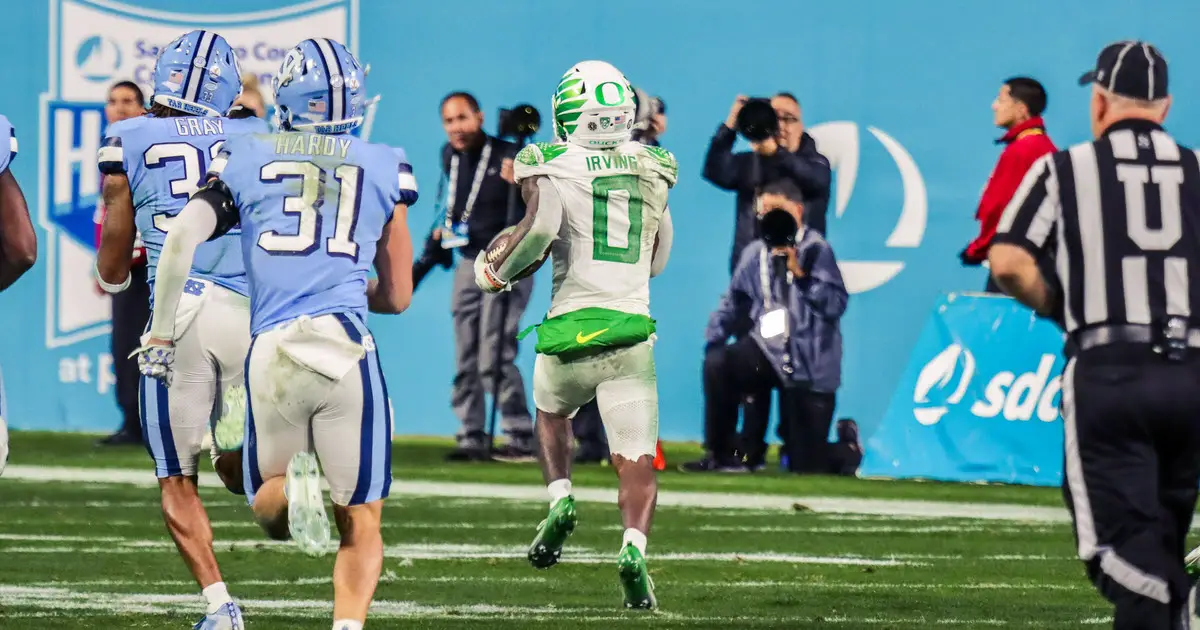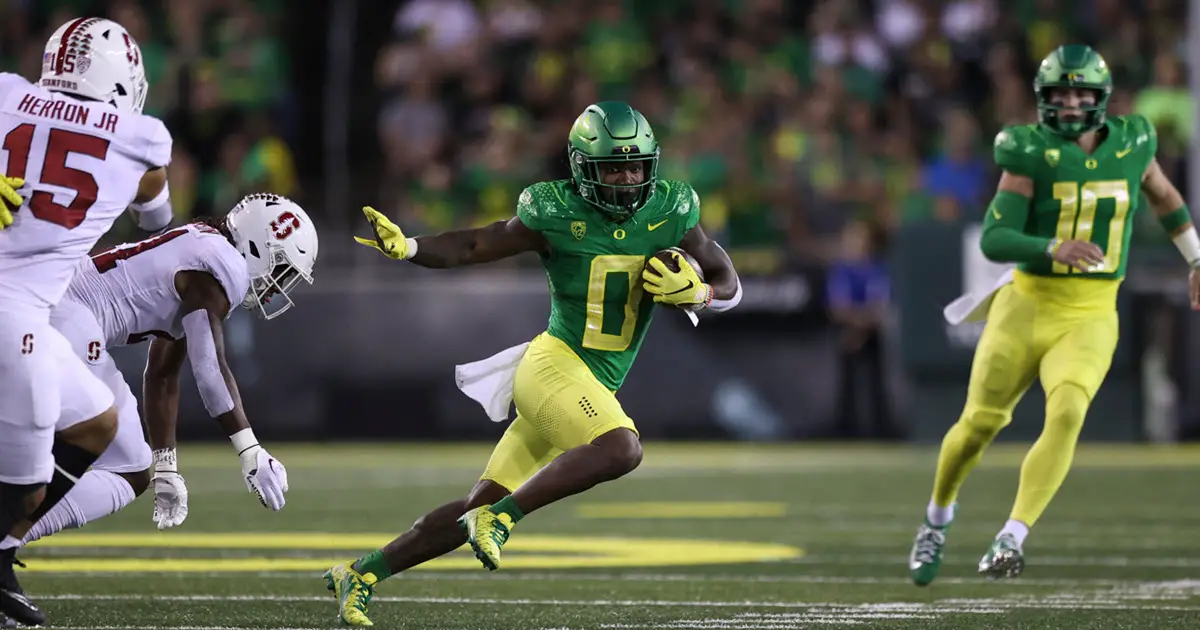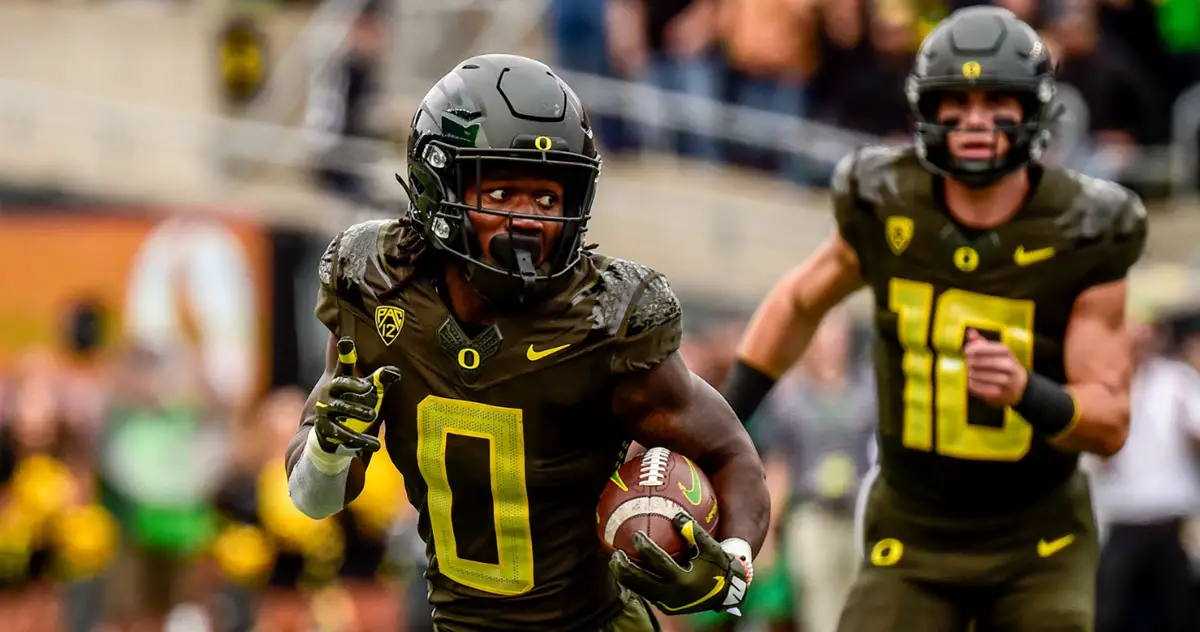Oregon had a strong one-two punch this last year in its two main running backs, Bucky Irving and Noah Whittington. Both had their moments and regularly generated explosive plays. Oregon also rotated in Jordan James and Sean Dollars at times, though in more limited roles. Dollars has since left the program and James will continue to grow as Oregon’s big-back option. Even the Best NFL betting websites for 2023 are becoming aware of the running back room for the Ducks.
Former Oregon offensive coordinator Kenny Dillingham went on the record multiple times stating that he was going to play as many running backs as possible to ensure a strong run game.
Running back by committee isn’t new, but so often last year this seemed to hurt Oregon’s offense more than help it. Sure, fresh legs are important and could gas the opposing defense as they struggle to keep up with a constant and punishing run game. Last season. though, it felt like Irving was just getting into a rhythm and beating the opposing defense into submission when the Ducks would sub him out for Whittington, who would get bottled up — and momentum would sputter.
This is not to say that Whittington is a bad back. Far from it; he was solid and explosive throughout the year, and had some games where he played great while Irving struggled.

Bucky Irving runs for a touchdown against UNC during the Holiday Bowl.
But Irving is a powerful running back. He has an ability to shrug off would-be tacklers and continue to pick up chunk yardage. Irving was the only rusher to run for over a thousand yards last season and he did so on only 156 attempts, which means he averaged 6.8 yards per attempt. By comparison, Whittington averaged 5.6, Bo Nix 5.7, James 4.1 and Dollars 5.5. For the sake of statistical analysis here, let’s throw out James’ number of 4.1 as he was used for mostly short yardage situations, many of which set a goal of him only picking up a yard or two between the tackles.
So the other runners of Whittington, Nix and Dollars all averaged 5.6 yards per carry among themselves. This really acts as a baseline for what the offensive line is generating for the run game and what is expected on a run play for each rusher. Irving is gaining 1.2 more yards per play on average, and he is generating those extra yards by breaking tackles and getting into the open field.
Irving often had the “hot hand” and due to the game’s running back rotation, he was pulled and replaced. One of the most telling stats is Irving’s number of touchdown runs, which was five. He also had three receiving touchdowns and one passing touchdown. And of Irving’s five rushing touchdowns, two of them came during Oregon’s bowl game against North Carolina, where he scored half of Oregon’s total touchdowns and was a big reason the Ducks managed to win that game.
For comparison, Whittington and James also scored five rushing touchdowns and Nix led the team with 14 rushing touchdowns, as many came through quarterback sneaks with some downhill power blocking from the offensive line. When Oregon was in the red zone it was Irving who was often on the sideline. This needs to change. Irving has an incredible balance of speed, power and the ability to break tackles.

Bucky Irving has all the weapons.
In the red zone Irving needs to be a part of the offense and not just stand on the sideline, especially when the desire is to run any sort of power play through a running back. Irving demands respect from defenses when he is on the field, and having both Irving and Nix as runners opens up the pass game (and the run game for Nix).
This was something that we frequently saw as Irving also emerged as an incredible weapon coming out of the backfield as a receiver. He often acted as a relief valve for pressure as a receiver and in a one-on-one match-up with a corner on the edge, stopping Irving from picking up positive yardage is going to be near impossible — and that’s not even mentioning the incredible perimeter blocking from Oregon’s wide receivers.
Irving needs to see the field more in new OC Will Stein’s offense in 2023. He is too good to be on the bench for long. It is important to get other runners on the field with fresh legs, but on a per-carry basis, Irving is Oregon’s best back and needs the opportunity to be a game changer.
David Marsh
Portland, Oregon
Top Photo By Eugene Johnson

Natalie Liebhaber, the FishDuck.com Volunteer Editor for this article, works in the medical technology industry in SLC, Utah.

David Marsh is a high school social studies teacher in Portland, Oregon. As a teacher he is known for telling puns to his students who sometimes laugh out of sympathy, and being both eccentric about history and the Ducks.
David graduated from the University of Oregon in 2012 with Majors in: Medieval Studies, Religious Studies, and Geography. David began following Ducks Football after being in a car accident in 2012; finding football something new and exciting to learn about during this difficult time in his life. Now, he cannot see life without Oregon football.

